What is Vedic Astrology?
Vedic astrology is the system of astrology which has its root in Vedas, the ancient Indian scripture. In India Vedic Astrology is also called Jyotishwhich means “light of the Vedas”. Astrology is a divine and noble science and it studies movement of the planets and their influence on us. Vedic astrology has its roots in Atarvana Veda. The Jyotishshastra, as described in Atarvana Veda consists of only one hundred and sixty five verses but contain enormous knowledge and wisdom which has passed from generation to generation and evolved in every sphere of Indian society.
Vedic or Hindu astrology is based upon principle of evolution in time. The Vedic astrologers believe that accumulated Karma of the past are brought into the present and the Karmas of this life will get carried forward in the next birth. Planets indicate the results of our past actions, viz., our future, which is divined by this extraordinary science. Astronomy is the foundation of any astrology and Vedic Astrology is not difference. Stars and planets are forces that control events and actions that influence our daily lives. These celestial bodies are placed in 12 houses also known as bhavas.
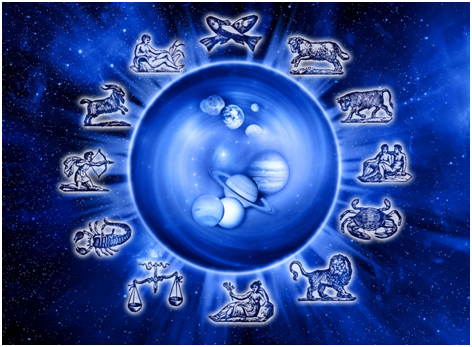
Everyone has heard of a Zodiac, but what exactly is a Zodiac. Imagine two small circles parallel to the ecliptic at the distance of 8 degrees on either side. The movement of the planets and the Moon are always within the belt formed by these two circles. This imaginary belt is called a Zodiac and is divided in 12 equal parts; each of 30 degrees extent called Signs or Rahis.
In a Zodiac, Stars or Nakshatras are fixed. Planets revolve around the Earth while staying within the links of the zodiac. The zodiac used by the western astrologers is called “Tropical Zodiac” and the Zodiac used by the Vedic astrologers is called “Sidereal Zodiac”. There are calculation difference between Tropical Zodiac and Sidereal Zodiac that is why a chart prepared as per Western Astrology can be different than the one prepared with Vedic techniques.
The Zodiac is divided in to 12 equal part; each of 30 degrees and this each division is called Sign or Rashi. Each Sign or Rashi plays a very important role at the time of interpretation of the birth chart.
The 12 Parts of the Zodiac are as under:
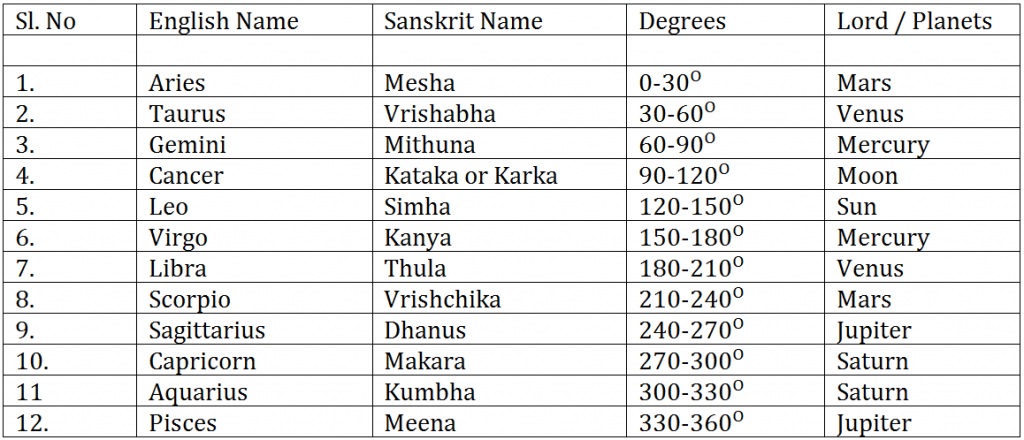
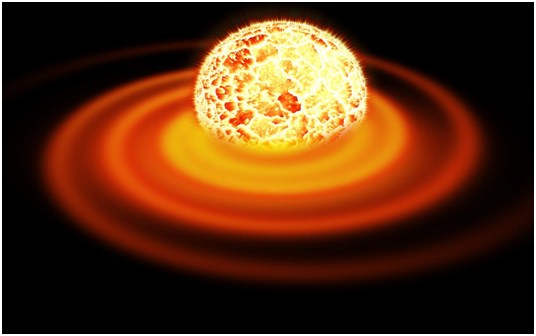
The term ‘planet’ used in Vedic astrology is referred to those celestial bodies that have the power of attraction. There are 9 planets recognized in Vedic astrology of which Rahu and Ketu are two imaginary points. They are the two points created by the intersection of the ecliptic, by the path of the Moon. Each of the planets influences us according to its nature.
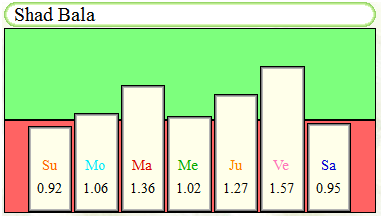
The 9 Planets as used in Vedic Astrology are given below:
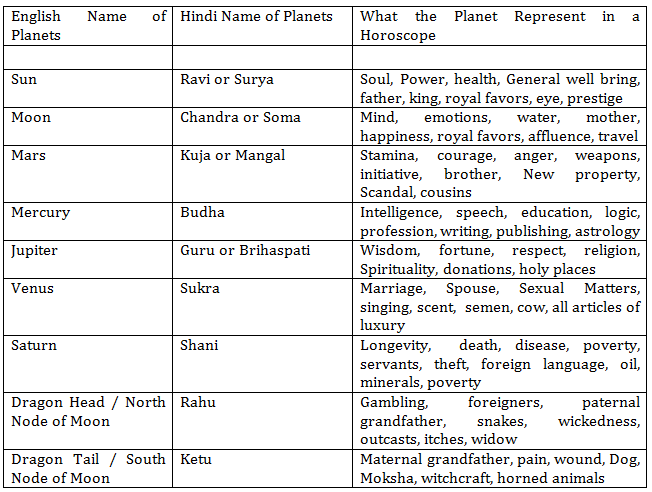
In North Indian astrology chart the houses are fixed and the signs or Rashi are variable depending upon the native’s time, date and place of birth. Each house represents different facets of human life. Below you will find brief Introduction of all 12 houses as per Vedic chart.
1. First House: (Self) , Ascendant, Lagna – This is the most important house in the horoscope, and its role is felt throughout the life of thenative. It represents the physical stature, appearance, complexion, health, vitality and personality of the individual.
2. Second House: (Finance, Family) – All finances are seen from this house, money gains or losses. This is the house of family of the native and is also the Marakastana or the death afflicting house as per Medical astrology.
3. Third House: (Courage, Initiative, Younger Brother/Sister) – Courage and the ability to achieve are seen from the third house. This house is also the house for native’s younger brother / sister, friends and neighbors.
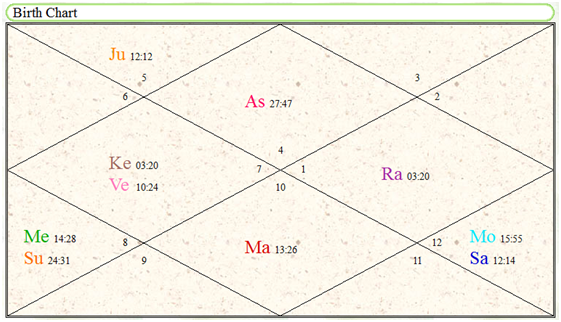
4. Fourth House: (Mother and Family Comforts) – Natives mother, residence, Native place, Luxury, Vehicles, farms, fields, academic education are seen from the fourth house.
5. Fifth House: (Progeny, Romance & Intelligence) – This is the house relate to children, love affairs, intelligence, higher education, speculation and investment in stocks, artistic talents.
6. Sixth House: (Enemy, Disease and Competition) – Short term diseases, debts, legal issues, success in competition, enemies, maternal uncle are represented by the sixth house.
7. Seventh House: (Marriage and all Partnerships) – Spouse, partners in business, marital life, relationship with spouse, type of spouse, gains or losses after marriage. This house is also a Marakastana or the death afflicting house as per medical astrology.
8. Eighth House: (Accidents and Death) – Longevity and span of native’s life, hidden treasure, legal will, insurance, inheritance, accidents, misfortune, theft, delay, suicide, sorrow.
9. Ninth House: (Fate and Fortune) – Fortune, spirituality, pilgrimage, father as a provider, higher education, long journeys, charity, intuition, fate are all seen from the ninth house.
10. Tenth House: (Profession) – Status, profession, power and prestige, recognition, high post and assignments, father, authority, honor from govt.
11. Eleventh House: (Gains) – Ambition and wish fulfillment, success in ventures, gain from profession, elder brother/ sister, recovery from illness are seen from the 11th house.
12. Twelfth House: (Expenses and Losses) – Wasteful expenditures, deception, bed comforts. Misfortune, disgrace and insult, separation, hospitalization, police custody, foreign settlement is all judged from this house.
In Hindu Astrology the fixed stars are known as ‘Nakshatras’. There are 27 Nakshtras in the zodiac. Each nakshtras thus measures to 13ᴼ 20’ and like the signs, nakshtras are also owned by planets. The difference is that while Rahu and Ketu which are the two shadows of the Moon, do not have any ownership of the signs, they are the owners of certain nakshtras. Each Nakshtra has four charan/pada. Each rashi therefore contains 9 charan/pada. The name of the Nakshtra and their lord are given below along with the sign in which they are posited.
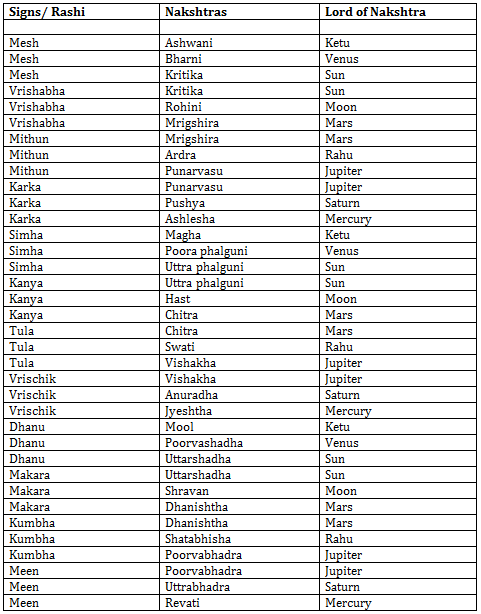
The purpose of astrology is to time the events in the natives life and a dasha system is followed to pinpoint the likelihood of events. There are several dasha systems for timing of events but the vimshottaridasha system is considered to be the best. The total vimshottaridasha period is of 120 years which is considered in our shastras as the maximum life period of humans.
Each of these 120 years is distributed to different planets as per table given below:
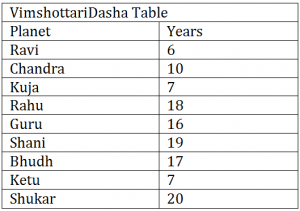
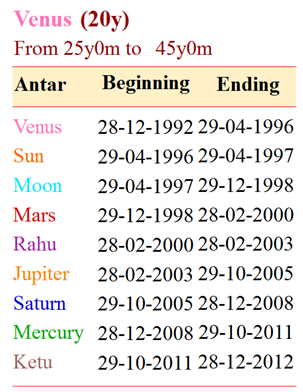
Gochara simply means movement of the planets in the Zodiac. This movement of planets are studies along with the VimshottariDasha period to determine the timing of the events. A dasha and gochar go side by side when predicting events. A dasha may be bad, but the gochar may be good which would rectify the bad.
In Vedic astrology Muhurta comprehends selecting the auspicious time for a particular event. It is a known fact that success in any work depends upon the moment at which it is commenced. A good muhurta gives the advantage of the natural forces to work in your favour and complete the work successfully. Events like marriage, entering a new house, renting a house, engagement, starting a new construction are some of the work that should be done in a good and auspicious muhurta.

